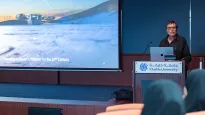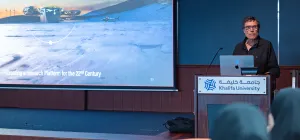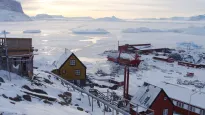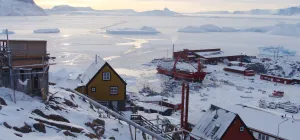First Wave of Scientists Return Home from First Field Campaigns of the Season

It’s the end of the year, and already the first teams of scientists for the 2019-2020 season have come and gone.
On December 21st, a plane bringing fresh food supplies and equipment from Cape Town arrived at the Princess Elisabeth Antarctica and returned the first scientists to take part in the 2019 -2020 season to Cape Town, where they spent a few nights before returning home to Belgium in time for Christmas.
Having arrived on the first intercontinental flight from South Africa to Perseus Airstrip just 60 km north of the PEA station, the scientists at the Princess Elisabeth accomplished their respective missions for the season in a month’s time.
CHASE
Preben Van Overmeiren from Ghent University (UGent) and Stefania Gili from the Université Libre de Bruxelles (ULB) spent their month-long stay in Antarctica visiting seven sampling sites the project installed during previous field campaigns under the CHASE project, which is investigating the kinds of particles that are in the air in East Antarctica, and if pollution from the rest of the world reaches such a remote part of the world.
The sampling sites (which lie along a 250 km transect from the ice rises at the Princess Ragnhild Coast to the Antarctic Plateau) have instruments with special filters that collect samples of airborne particles over time. Each site has an instrument that samples organic compounds and an instrument that samples inorganic compounds from the air.
The special filters taken from the sampling sites have been collecting air particle samples since the last time members of the CHASE project visited the sampling sites during the 2018-2019 season. Preben and Stefania removed the filters and replaced them to continue collecting samples of organic and inorganic particles for another year.
During their time in Antarctica, the CHASE scientists also took samples of organic and inorganic atmospheric particles on a weekly basis near the PEA station using active sampling methods. Even though both CHASE scientists returned to Belgium in time for Christmas, Benoît Verdin from the International Polar Foundation team will continue to do active sampling of the atmosphere at the station until the end of the season.
All filters collected during the 2019-2020 season will be shipped out on the last cargo flight leaving from Perseus Airstrip in February. Once they arrive in Belgium, researchers from the many academic institutions participating in the CHASE project will analyse the compounds they collected in the filters.
MASS2ANT
After two successful seasons, including one in which ice cores drilled to a depth of 260 meters were extracted at an ice rise along the Princess Ragnhild Coast, the final season of field work for the MASS2ANT project involved returning to the boreholes that were drilled in two separate ice rises during the previous two seasons.
The field team measured snow and ice parameters around the boreholes such as temperature using an optical televiewer, surface strain around the borehole using GNSS and radar, and crystal orientation and fabric of the ice around the borehole using phase-sensitive radar.
The team - which consisted of Frank Pattyn from the Université libre de Bruxelles (ULB), Thore Kausch from the Technical University of Delft and Eric Keenan from the University of Colorado Boulder - also removed automatic weather stations that had been placed on the two ice rises sampled during the project to record weather data over the course of the project. The team also used a Snow Micro Pen developed at SLF in Switzerland to measure surface accumulation and variability (density and depth of snow) at 665 points around each of the ice rises.
The data collected from the MASS2ANT project will contribute to the ever-growing volume of data tracking the surface mass balance of the Antarctic Ice Sheet, or the amount of ice that the massive ice sheet covering the continent is gaining or losing.
Alain Hubert and Raphael Richard provided field guide support during the field campaign.
POPE
The POPE project, which aims to collect reference observations on the interactions between clouds, precipitation and complex terrain in Antarctica using a suite of remote sensing and in-situ instruments all based at ground level, had a highly productive first season at the Princess Elisabeth station.
The two scientists responsible for deploying the instruments this season, Alexis Berne and Alfonso Ferrone from the Federal Polytechnic Institute of Lausanne (EPFL) in Switzerland started installing their instruments on November 22nd, a day after their arrival at the PEA station. They put a number of instruments at or in the immediate vicinity of the Princess Elisabeth station, including Lidar (to measure atmospheric temperature and aerosols), MXPol radar (which tracks movement of clouds), and micro rain radars (which tracks fine precipitation).
Both Guus Luppens and Johan De Muylder (from SYSTECH) provided technical support to their work with the mobile solar-powered units they built to power the radar instruments with renewable energy. Emmanuel Poudelet provided field guide support.
Alexis and Alfonso stayed for one month to install everything. Alexis returned home on December 21st, but Alfonso is styaing behind to continue to collect data and dismantle all of the equipment at the end of the season (February 13th).
LOSUMEA
Another Swiss scientist who arrived on November 21st is staying until the end of the season. As in previous seasons, Hendrick Huwald, who is also working with the Federal Polytechnic Institute of Lausanne (EPFL), is staying behind to continue taking measurements for the LOSUMEA project.
The project is complimentary to the work of the POPE project in that it focuses on snow accumulation, transport and erosion processes to understand and quantify local changes in the mass balance of the ice sheet in the vicinity of the Princess Elisabeth Antarctica Research Station.
Since the 2016-2017 season, two snow drift stations near the PEA station have been collecting data on snow particle transport, as well as related meteorological variables such as wind, snow depth, and surface temperature. Members of the station team maintained the instruments over the last few seasons, and have improved the instruments to also allow them to collect data on heat flux.
During the current season, one of the snow drift stations has been completely rebuilt on higher ground after snow accumulation was starting to bury its instruments. The second station has been dismantled, moved, and rebuilt on the Antarctic Plateau so it can be in a place where constant katabatic winds (which discourage snow deposition) are more dominant than close to PEA. A solar radiation sensor was added to both stations to measure surface energy balance.
Instead of doing terrestrial laser scans in previous seasons, the station staff have been using a surveying drone to conduct areal photogrammetry over selected areas of interest, including in the vicinity of the two snow drift stations, the area around the Princess Elisabeth Antarctica, and around Utsteinen Nunatak.
Next, please!
The station team is eagerly looking forward to welcoming the scientists who will arrive during the second half of the season, including 2018-2020 Ballet Latour Antarctica Fellowship Laureate Dr. Kate Winter, who will compelte the second of her two seasons in Antarctica.
Download





















